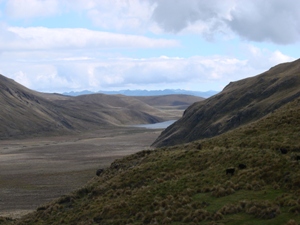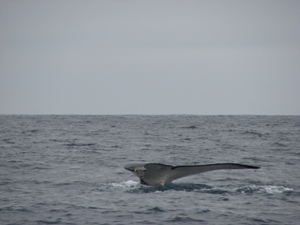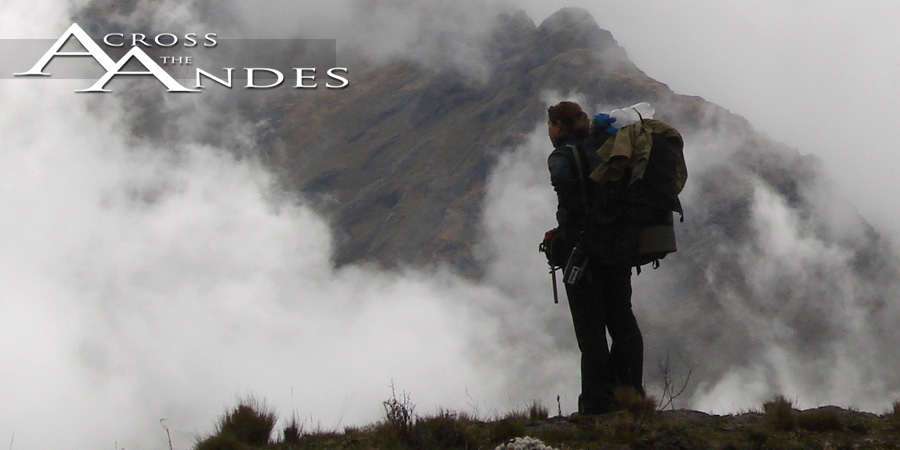Encounters
By Deia Schlosberg
August 24, 2006

We began this chapter with the yearly town celebration in Guasuntos. Missing the three prior days of bull fighting or racing or whatever it was they did in a huge makeshift ring with bulls, we arrived just in time for the Dance. A whole evening and night (until 6 a.m.) of an entire town and visitors dancing to a live band in a huge, illuminated square. Lots of drinks and vendors. Lots of barrachos. An entire community participated--young kids and older folks, all dancing together. By four in the morning we were beat and in need of a place to stay. With no hostels in the town and the local cop telling us it was way too dangerous to hike south of town to camp, we ended up "sleeping" on the floor of the police station, directly across from the continuing festivities. The next morning we finished our stint on the Riobamba to Aluasí railroad and left the flat wandering tracks for rolling hills of assorted grains. After the most amazing display of rainbowage I've ever seen, we encountered a small hacienda near San Carlos, whose residents were happy to let us sleep on their land in exchange for an informal show and question session of our gear setup and trip.
Our much-needed sleep was cut short early in the morning as one of the men of the hacienda crawled his way under the rainfly to amiably ask us where we were going and where we were from and our views on religion. We complied in answering out of startled confusion, but were really quite annoyed. It's been made clear repeatedly that there is a huge cultural difference between the amount of personal space expected in the U.S. and that expected in Ecuador. For the most part, I feel like we've been very accepting of this difference and going along with it fairly gracefully, but after a point, it can get to be a bit much i.e. a strange man crawling into our tent without warning. There have since been two other episodes of people throwing rocks at our tent with us in it to get our attention, and still others of kids running past repeatedly to see how close they could get to us. It's understandable from their side, never having seen gringo backpackers before and wanting to satiate their curiosity, but from our side, it gets wearisome being a novelty and not just a person.
It was also on this morning that Gregg found himself suffering with the same nasty bug that I was still getting over. Hit with fevery nausea and weakness, he decided, since we were close to a road, that it would be best to go to town to recover, where meds and beds were available to expedite the process. For the next several days we rested in Aluasí, where Gregg got painkillers and an IV drip at the local hospital, and where we both received flagyl to finally rid ourselves of what was probably a particularly nasty version of giardia. We figure we got it from the chicha in the jungle, a traditional drink that even many Ecuadorians won't touch because of how it's made (it involves all the women of a village chewing and spitting yuca into a large vat). Not wanting to be ungracious, we couldn't refuse, but perhaps next time, tact will have to make way for sparing us several weeks of illness.

Once Gregg was under ten trips a day to the bathroom, we picked up our hike where we left off, over cropland for a while and soon back into more serious terrain. Descending into deep canyons, we made our way down into the steep river valley that separated us from the starting point of our next trek--Achupallas. As we ascended the other side of the river valley we began to see more evidence of Incan remnants in the form of restraining walls and paths. The trek from Achupallas was to follow an Incan road to Ingapirca, the most significant site of Incan ruins in Ecuador. From the dirt road leaving the small town, we turned south onto a path paved with dark, rounded stones and lined with stone walls. This was the road of the Inca. The Incans built a hugely extensive network of roads throughout their empire for trade and to deliver mail. Many bits of these roads are left, but not usually in large sections, like this stretch and the more famous Inca Trail in Peru to Machu Pichu. We followed the trail along a river until dark, where we found a small, earth and grass herder's hut to sleep in. The next day was probably the most beautiful hiking of the trip so far; we walked the length of three enormous and incredible valleys. In the first, we climbed steeply up the valley wall and traversed high above several minor Incan sites through strong mountain winds. The second valley had us following the Incan road down the valley floor over marshy ground, and the third led us above grazing cows and deep clear pools to a sizable ruin by the time the sun was setting. After doing some significant cleanup work at the site (It's pretty disgusting how ridiculous people can be; who goes to the bathroom on and leaves their toilet paper and other trash all over ruins thousands of years old?), we had a good night sleep surronded by the stone remnants. The next day we descended several thousand feet into Ingapirca, where we enjoyed the large ruins site from outside, not wanting to pay the entrance fee with the hordes of tourists there. In the actual town of Ingapirca we ran into a local who had spent many years travelling around the states and seemed very happy to be speaking English with us. Ralphael ended up giving us a tour of the town and all the new development and explained how the American policy of Neo-Liberalism was profoundly affecting Ecuador. The impact mainly took the form of brightly-painted, badly-designed houses covering the hillsides, all funded by money sent back from locals now working in New York. We finished the hike by going through some small towns and tree-blessed countryside, all with innumerable barking dogs, and eventually caught a bus into Cuenca.
Cuenca (or thereabouts) is where Gregg's good friend from the trail has been living for the past couple of years, working for Peace Corps. We weren't sure how we were going to find her there, but figured things would work out. Our first stop in town was the post office to pick up a couple of packages we had sent ourselves, and lo! --There in the line stands Coyote, mailing a mutual friend a birthday card. Cuenca is not by any means a small city, and yet, completely by chance, there we were in the same line. We spent the evening in wonderful conversation over a wonderful meal with other Peace Corps volunteers. Refreshing is an understatement, for as amazing as the trip has been, and as much as we love each other's company, it is quite challenging to only connect with one other person for seven weeks straight. New ideas and new humor and new stories were very welcomed. The next morning Gregg went with Coyote back to her Peace Corps site, a small town call Jima in the mountains outside of Cuenca. The task for the day was slaughtering a pig, and afterwards a guinea pig (cuy) as a special meal for us, Coyote's visiting friends. Having just given up my 11 years of vegetarian living for this trip, I chose to take the second bus out after doing some errands in the city, conveniently avoiding the pig killing. However, I do like the idea of being directly connected to my food and the processes involved in obtaining what we eat, opposed to the 47 million degrees of removal that exist so often in the States. Perhaps I'll get to that point later in this trip. Gregg seemed profoundly affected by the experience and I respect his decision to be involved. By the time I pulled into town, he was sitting by the fire, spit-roasting the cuy, grinning, with "I [heart] U" spelled out in pig intestines in front of him on the ground. So romantic. The family that raised the animals was whom Coyote had become closest to in her time there, and so put on the lunch for us as an honor. The cuy didn't taste at all like chicken. But it was good, and very distinct. We spent the rest of the night catching up with Coyote and listening to her sick raps and laughing.

A brief return to Cuenca and we were off to the coast, having heard that it was peak season for humpback whale migration to the area, with thousands of them just off the coast, mating and birthing in the warm equatorial waters. Not knowing anything about where we were headed, other than the possibility of whale watching in the area, we jumped on a bus to Salinas. The small city turned out to be a beach-side vacation town, mostly with Ecuadorian tourists, but with a smattering of Spanish, French and American as well. Our first trip out to the whales was with a regular company, but we soon befriended a couple of researchers working with another company, who helped us get a reduced fare because of our passion over the huge sea beings. Three days we spent on the water with the whales. We saw breeches, dorsal fins, pectoral fins and tails---far away on the horizon and right next to the boat. We learned all about the habits of the whales, theories on their behaviors, and research techniques. A huge thanks goes out to Jessica and Andréa for their willingness to share their knowledge with us.
We're now back in Cuenca, where we will soon leave for the trail again, taking off through Cajas National Park and heading for the border. Peru or bust.







